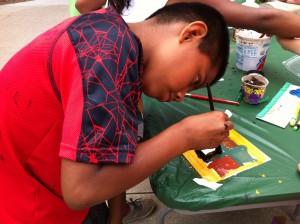
Mud on canvas? Well, sort of…
Take some raw soil, mix it with a water-based medium such as honey, water or glycerine, and what do you get? If you guessed “soil paint,” you are correct.
Did you know that artists’ paints were all soil-based – until about 150 years ago chemists figured out other ways of creating the more commonly manufactured colors used today through machine-grown pigments. Most modern paints are created synthetically rather than from pigments derived from earth, soil, rock, metals, plants, mushrooms, insects and/or shellfish.
Artist and soil scientist Rhonda R. Janke could buy synthetically created paint to create her works. Why take this easy way out when she finds joy in creating paint from scratch – that is, from the earth. Depending on how much paint one needs and availability of materials, soil paint can be an economical alternative to purchasing paint, she said.
Here’s a link to a handout developed on how to make paint, comments on toxicity (soil paint is a lot safer than contemporary paints) and the historical context: http://parideazafarmart.wordpress.com/workshop-on-making-paint-from-soil/.
This is free information on making the following types of paint:
- Casein
- Egg tempera
- Encaustic
- Gouche
- Oil paint
- Pastels
- Water color paint
“Paint was mysterious and confusing to me until I did a lot of reading and experimenting. The mystery has turned into empowerment, but hasn’t lost its magic!” Rhonda states.
Empowered is a good word for the arts in general impact us – art makes us feel powerful, like we can do anything if we set our minds and focus on what we want to accomplish. The power of the earth is its ability to grow plants from seeds. The power of some artists is to take soil from the earth and mix it with other natural substances to create a medium for expression.
Rhonda invited children and adults to share in the “magic” a few weeks ago during an Open House celebrating the beginning stages of the Meadow project. Representatives from collaborating departments and local Boy Scout Troops 74 and 75 also were there and participating in the creation of soil-based paints.
At the time, we hadn’t yet planted seed. Rather than disturb the soil of the Meadow, Rhonda made a metaphorical connection by bringing three buckets of local soils along with yellow, orange, green and black pigments made from the soils of Italy, Spain and elsewhere. She brought other materials to complete the recipe for paint. Besides pigment, other essential ingredients for paint include a binder that makes it stick together and an adhesive to make it stick to canvas, wood or paper. Open House guests worked on paper, and the hope was that they began thinking about the physical link between art and nature – the fact that “soil can make great art, and has been used for centuries,” Rhonda said at the site.
What lay below our feet matters for the growth of plants as well as the wonder of materials for everyday use.
In her artist statement, she writes: “I feel that materials used can be part of the message… Making the paint and fiber is as important as making the image. I also see nature as a collaborator, not as a resource to be exploited. To read her complete artist statement, go to http://parideazafarmart.wordpress.com/biographic-data/.
Also, here’s another link some contemporary soil artists: http://parideazafarmart.wordpress.com/favorite-soil-artists/.
“Making paint and using local materials will probably be a major part of my practice from now on, since it fits with my value system of using non-toxic, local materials, and also fits with my aesthetics of knowing where things come from, and how they are made, in addition to just seeing how they look,” Rhonda states.
The Meadow project is intended to bring us back to basics, too. One of the benefits of native plants includes no need for pesticides and fertilizers and less need for mowing. The creators of the Meadow intend this special place to be a meaningful compliment to the museum, and part of that is to provide an extension of the work of Beach educators to make meaningful connections among art, science and enjoyment of the natural world.


